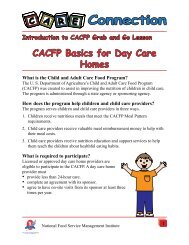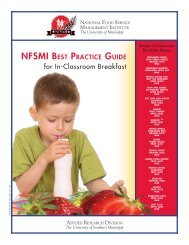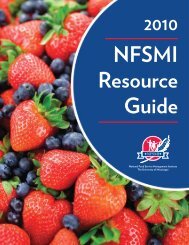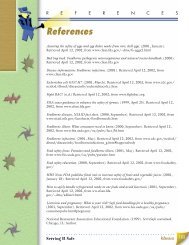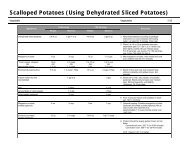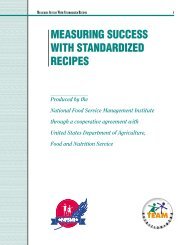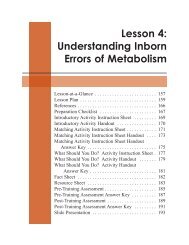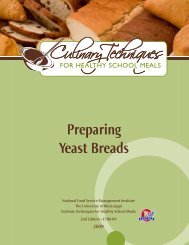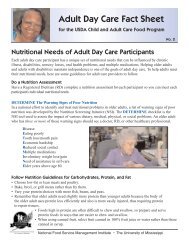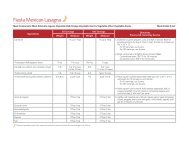financial management information system - National Food Service ...
financial management information system - National Food Service ...
financial management information system - National Food Service ...
You also want an ePaper? Increase the reach of your titles
YUMPU automatically turns print PDFs into web optimized ePapers that Google loves.
S ECTION 4FINANCIAL A NALYSIS AND P ROGRAM E VALUATIONMethod # 2: Overhead Contribution + Desired Profit PercentageThis is a modification of the desired food cost percentage. The food percentage used in establishing a selling price isdetermined by first establishing the total cost percentage of all other nonfood expenditures plus a desired profit percent.The percentages for all nonfood costs, including labor, plus the desired profit (net gain) percentage are subtracted from 100percent, leaving the percentage that is available to cover food costs.Selling Price = standard food costs100% - (nonfood cost percentages + profit percentage) = percent allowed for food costsAssume the cost of a slice of pizza is $.52 and that all nonfood costs including labor make up 65% of total revenue. Theschool foodservice department has determined that a 5% increase in revenue for nonreimbursable food items is needed inthe budget for the current operating year. The base selling price for a slice of pizza can be calculated using the followingformula.Example: = $.52 (standard food cost for 1 slice of pizza)100% - (65% for nonfood cost + 5% for profit) = 30% allowed for food cost percentageSelling Price = $.52 = $1.733330 ÷ 100 or .30If the price is rounded to $1.75 for each slice of extra pizza sold, this provides $1.23 per pizza slice to cover other costs andprofit after allowing $.52 to cover food cost. In this scenario, the customer may perceive the value of a slice of pizza to beless than $1.75. If so, the district will need to identify other areas in the budget to adjust.The price of any combination of food items that qualify for a reimbursable meal should exceed the price charged for themeal so that is advantageous for the student to purchase the reimbursable meal. Students should be made aware of the costadvantage of purchasing a nutritious reimbursable meal as opposed to selecting food items separately.ProductivityEvaluating productivity is important to the <strong>financial</strong> success of the school foodservice program. The number of lunches ormeal equivalents served per labor hour represents the primary measure of productivity for school foodservice programs.Knowing the rate of production in the school setting is essential in formulating budgets and determining labor needs.Meals per Paid Labor HourThe productivity index of meals per labor hour (MPLH) is used by many school foodservice administrators to monitor theefficiency of their operation and to determine appropriate staffing. This important <strong>information</strong> indicates to administratorswhether they are making good use of their resources. This measure can help in determining how many employees areneeded in a single production unit or throughout the district. The MPLH index is most effectively used to compare laborutilization within a <strong>system</strong> because labor is so dependent on the type of operation used in food production. For example,factors that may affect MPLH as a productivity measure are:• size of operation• number of serving lines• type service provided• scheduling of lunch periodsN ATIONAL F OOD S ERVICE M ANAGEMENT I NSTITUTE 74



